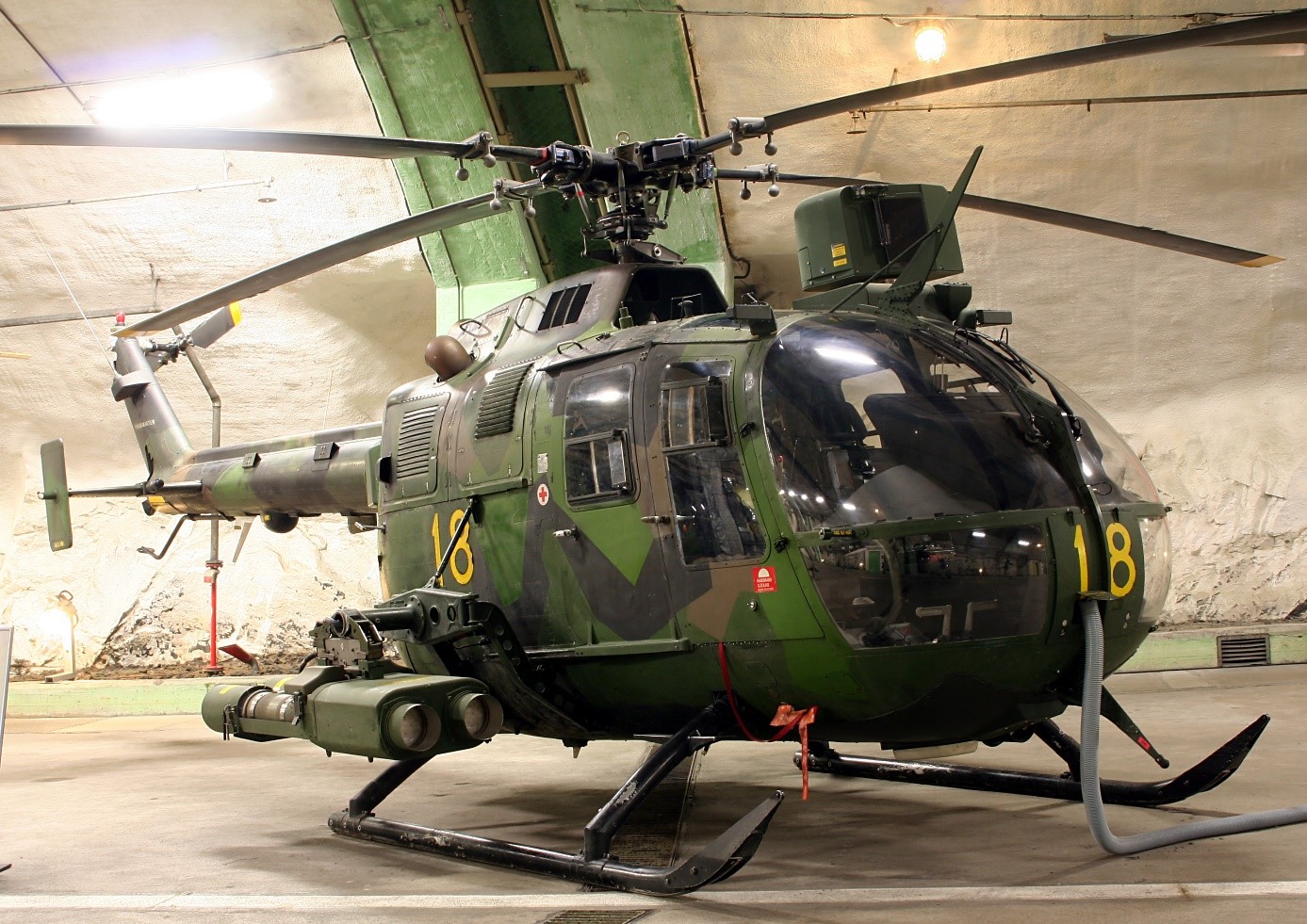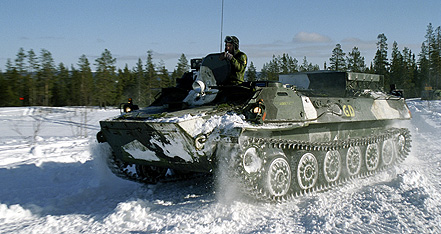Anti-armour helicopters at last
It was in August 1987 that the first of a total of 20 Hkp9 helicopters were delivered to Sweden. The helicopters would be divided between two Army Aviation battalions, AF1 and AF2, with one company of anti-armour helicopters each. These Swedish helicopters differed from those used by the German Army in several ways. They were equipped with a new version of wire-guided TOW missiles, called the Robot 55. As the same type of missile was used by other Army units this was naturally a practical measure. But that was not all. In order to keep the helicopters as unobtrusive as possible, they were all equipped with a new missile aiming sight, developed by SAAB and called the HeliTOW.
This sight was located on the roof of each helicopter, which caused some difficulty for the gunner’s posture but also offered possibilities. The sight was placed on the left side, since the main pilot seat in a helicopter is always traditionally on the right side. However it would be the gunner who temporarily was in command during action.
Because the sight was located so high up the gunner could observe the enemy while the pilot hovered behind a hillock or a screen of trees with only the rotor and sight in view, providing the helicopter better cover from enemy fire if it was detected by the intended target. Nevertheless when it opened fire the helicopter had to become visible.

Hkp9A number 18 can be seen today in the Aeroseum, fully equipped with tubes for four wire-guided TOW missiles, a missile sight and the special wire cutters to cut through suspended electrical power lines Photo: Peter Langsdale.
Anti-armour hunting tactics
The anti-armour companies formed strategic resources that could be brought in to where they were most needed in order to fight against enemy armoured vehicles. The wide and desolate areas in the north of Scandinavia also offered good possibilities for helicopters to use the terrain in order to move forward to advantageous positions for attack, and the withdraw afterwards. Every helicopter was equipped with four TOW missiles, each with a range of more than 4 kilometres. Whatever the purpose of an attack, the most usual tactic that would be used is an ambush. The helicopters sought to attack the enemy in terrain that they had chosen themselves, and from positions that they had been able to study beforehand. A limiting factor was that the sight did not work at night, so any action must be carried out in daylight. The helicopters would operate either singly or in pairs. If a complete company was engaged against the same target the pairs would separate and either attack in sequence or from different directions.
An important reason to fly alone or in a pair was that the Swedish anti-aircraft units were trained to open fire against groups of three or more helicopters since these would most likely be hostile. . Swedish helicopters usually appeared alone or in pairs, so the Hkp9s would follow suit.

The MT-LB (Multi-Purpose Towing Vehicle Light Armoured) is a Soviet multi-purpose fully amphibious auxiliary armored tracked vehicle, particularly suited to the kind of terrain found in the far north of Sweden. It has good traction in rough terrain and can transport soldiers, equipped as either a command of engineering vehicle. This picture shows an MT-LB in Swedish service, designated the Pbv 401. Photo: Franke
Setting a trap
But the anti-armour helicopters also trained to co-operate with other types of weapon in order to increase the effectiveness of an attack. Helicopters were already being used for directing artillery fire, which was also the case for the Hkp9. Damage caused by the artillery could either block the route taken by enemy forces, force them to halt or change direction to make them an easier target for a helicopter ambush. Artillery fire could also be called in after an attack to protect helicopters as they withdrew.
The artillery could also be supplemented by laying mines. In addition, mines themselves could create a sufficient impediment to temporarily halt an armoured vehicle force and either make them stop altogether or at least slow them down. In this situation armoured vehicles are most vulnerable to attack by TOW missiles. Now one did not always have suitable mines to use, and in this case would enlist the help of an engineer battalion. A small force of these troops could usefully be flown out to the location to be mined with the necessary equipment. The job of the engineers was to use mines and work in the field to channel the movements of the opponents around the battlefield. Once that job was done, the engineers would be evacuated by helicopter after which it was a matter of waiting and hoping.

The tracked Bandkanon 1 (Tracked Howitzer 1) was Sweden’s most powerful artillery weapon and was used as divisional artillery in Northern Sweden. It had a high rate of fire and long range. It would be utilized where the need was greatest, for example against enemy armour that might have broken through, or even in combination with an Hkp9 attack. Photo: Miliseum
The concept was tested in a number of exercises, and from the helicopter companies’ point of view the method worked well. Clear limitations were that the helicopter missile sight could only be used in daylight, and that there was absolutely no protection for the helicopter and its crew. The two anti-armour helicopter companies existed between 1987 and 2000, when they were disbanded. Afterwards the Hkp9 was no longer used for anti-armour, but instead acted as transport helicopters until they were all withdrawn from service in 2009.
What could 20 helicopters have achieved?
The value of anti-armour helicopters has often been brought into question, just as fighting helicopters in general have sometimes been played down. The attitude of the Swedish Air Force has always been like that of a stepmother and from the airborne weapon point of view the helicopter’s survival against modern fighter jets often brought into question. However those tests that have been carried out nevertheless showed that it is difficult to detect low flying helicopters from a jet aircraft and by no means certain that an attack would succeed. Therefore enemy attack helicopters such as the Mi-24 would have posed a major threat. However their greatest threat would have been from ground-based anti-aircraft fire and hand-held weapons.
Tests performed against tanks provided the expected results. Tanks that moved quickly and did everything possible to use the terrain for protection were hard to hit. But this also resulted in fighting vehicles not being able to fight effectively. If they acted in a more normal manner there was a much greater chance that the helicopters would hit them. So to focus on attacking while tanks were unprepared for an attack or for other reasons could not move quickly, was the best strategy.
IF one compares with the way the Syrian Gazelle helicopters performed their missions in Lebanon in 1982, there seem to be several parallels. Despite Israel succeeding in gaining air superiority and causing severe losses to the Syrian ground attack aircraft, The Gazelle helicopters continued to be a force to be reckoned with and caused the Israeli armoured units heavy losses even though Syria had no more than 20 anti-armour helicopters. The Gazelles usually appeared in pairs, used the mountainous terrain to hide their approach and were not afraid to enter areas that were really under the control of the Israeli forces.
The helicopters were therefore able to conduct surprise attacks and then withdraw as quickly as they had arrived. The gravest threat to them was not fighter aircraft or anti-aircraft weapons but fire from hand-held weapons and those carried by fighting vehicles. The four helicopters that were shot down or forced to make emergency landings were hit by hand-held weapons, tank machine guns or an anti-armour missile fired from an Israeli helicopter. Anti-aircraft vehicles also damaged a further two Gazelles, but at least one, despite severe damage, could be flown home itself. The anti-armour helicopters, namely both the Syrian Gazelles and Israeli MD.500s, often pinpointed their targets long before their opponents realised they were there. This meant that the helicopters could avoid making attacks while there were anti-aircraft vehicles nearby.
In this situation it was paying attention, quick reactions and the ability to improvise that enabled individual soldiers and vehicle crews to determine whether they could with their own weapons drive off the helicopters.
If the worst happened and Swedish anti-armour helicopters were forced to engage attacking Soviet armour they would probably have caused the attackers severe problems and forced their armoured units to move more carefully and thereby delayed their advance. This would have enabled new defensive lines to be set up. This seems to have been the Swedish plan. Continuous ambush attacks would gradually wear down the attacking units and above all spread fear and apprehension among the opposing soldiers.
In addition one must note that out of the five Gazelles lost by Syria one was able to fly home despite severe damage, two managed to force land and thereby save the lives of their crews even though they became prisoners of war and their helicopters seized as prizes by Israel. They were not so badly damaged that Israel could return them to flying condition. The two Gazelles that were totally destroyed were hit by anti-armour missiles from an Israeli Cobra helicopter and by a shell from a tank’s cannon, weapons that were really intended to destroy tanks. This says something about how difficult it can be to actually shoot down a helicopter.
